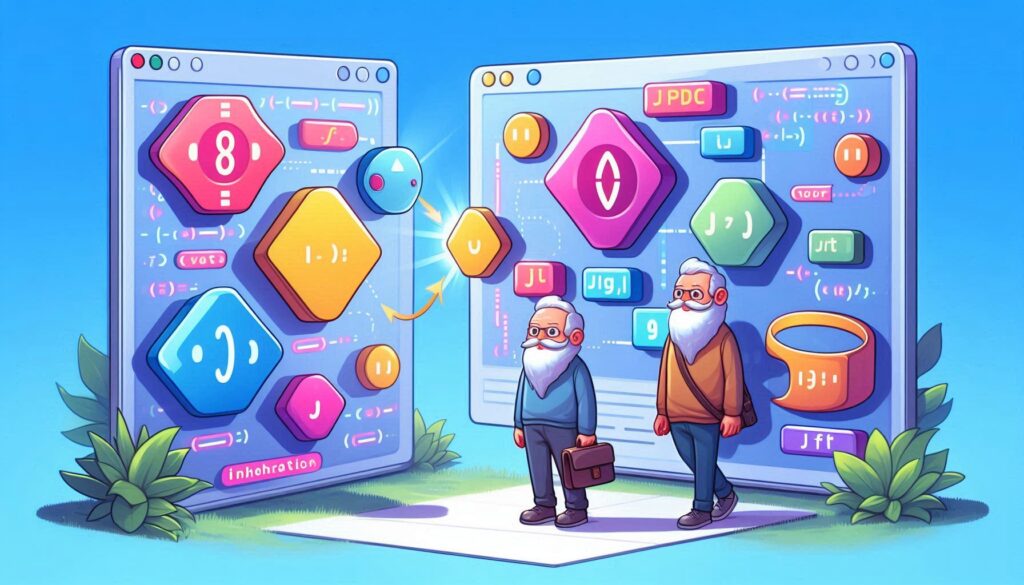JavaScript is one of the most widely used programming languages, especially for web development. One of its core concepts is the prototype, which plays a crucial role in how JavaScript handles inheritance. Understanding prototypes and inheritance is key to mastering object-oriented programming (OOP) in JavaScript. This article will explore these topics in simple terms, breaking down their concepts and practical uses.
Table of Contents
What Are Prototypes in JavaScript?
In JavaScript, every object has an internal property called [[Prototype]], which is essentially a reference to another object. This object serves as the prototype of the original object and provides it with properties and methods that it can access.
Key Points About Prototypes:
- Prototype Chain: If an object does not have a specific property or method, JavaScript looks for it in the object’s prototype. This chain continues until it either finds the property/method or reaches the end of the prototype chain.
Object.prototype: At the top of the prototype chain isObject.prototype. If a property or method is not found in any object along the chain, JavaScript returnsundefined.- Shared Methods: Prototypes allow objects to share methods and properties, saving memory and improving efficiency.
Example:
Here is a simple example to demonstrate how prototypes work:
function Person(name) {
this.name = name;
}
Person.prototype.greet = function() {
return `Hello, my name is ${this.name}!`;
};
const john = new Person('John');
console.log(john.greet()); // Output: Hello, my name is John!In this example, the greet method is not defined directly on the john object but is available through the Person.prototype.
Understanding Inheritance in JavaScript
Inheritance in JavaScript allows one object to access the properties and methods of another object. Instead of creating duplicate methods for each object, JavaScript uses prototypes to share functionality.
Types of Inheritance in JavaScript:
- Prototype Inheritance: Objects inherit directly from other objects via the prototype chain.
- Class Inheritance: Introduced in ES6, the
classsyntax provides a cleaner way to implement inheritance while still using the prototype mechanism under the hood.
Example of Prototype Inheritance:
const animal = {
eat: function() {
console.log('This animal is eating.');
}
};
const dog = Object.create(animal);
dog.bark = function() {
console.log('Woof!');
};
dog.eat(); // Output: This animal is eating.
dog.bark(); // Output: Woof!
Here, the dog object inherits the eat method from the animal object through the prototype chain.
Example of Class Inheritance:
class Animal {
eat() {
console.log('This animal is eating.');
}
}
class Dog extends Animal {
bark() {
console.log('Woof!');
}
}
const myDog = new Dog();
myDog.eat(); // Output: This animal is eating.
myDog.bark(); // Output: Woof!Using the class syntax, we can achieve the same inheritance behavior with a more readable and modern approach.
The Prototype Chain in Detail
The prototype chain is a fundamental concept in JavaScript inheritance. It determines how JavaScript searches for properties and methods in an object.
- Accessing Properties:
- When you access a property or method on an object, JavaScript first checks if it exists directly on the object.
- If not, it checks the object’s prototype.
- This process continues up the chain until the property/method is found or the end of the chain is reached.
- Overriding Properties:
- If an object defines a property with the same name as one in its prototype, the object’s property takes precedence. This is called “shadowing.”
Example:
const parent = {
greet: function() {
console.log('Hello from the parent!');
}
};
const child = Object.create(parent);
child.greet = function() {
console.log('Hello from the child!');
};
child.greet(); // Output: Hello from the child!In this example, the greet method in child overrides the one in parent.
Advantages of Prototypes and Inheritance
Prototypes and inheritance offer several benefits in JavaScript programming:
- Memory Efficiency: Shared methods and properties reduce memory usage by avoiding duplication.
- Code Reusability: Developers can reuse existing code and extend it to create new functionality.
- Flexibility: Objects can dynamically inherit and override properties and methods.
Common Pitfalls and Considerations
While prototypes and inheritance are powerful, they come with some challenges:
- Overuse of Inheritance:
- Overcomplicating code with deep inheritance chains can make debugging difficult.
- Favor composition (combining objects) over inheritance where appropriate.
- Prototype Pollution:
- Accidentally modifying the prototype of a core object (like
Object.prototype) can lead to unexpected behavior.
- Accidentally modifying the prototype of a core object (like
Avoiding Prototype Pollution:
Object.prototype.newProperty = 'Oops!';
const obj = {};
console.log(obj.newProperty); // Output: Oops! (unexpected behavior)To prevent this, never directly modify core object prototypes.
Understanding prototypes and inheritance is essential for writing efficient and scalable JavaScript code. Prototypes allow objects to share methods and properties, while inheritance lets objects build on each other. By mastering these concepts, you can harness the true power of JavaScript’s object-oriented capabilities.
When using prototypes and inheritance, always strive for clean and maintainable code. Avoid overly complex inheritance hierarchies, and use modern class syntax when appropriate for clarity. With practice, you’ll be able to leverage these tools to create robust JavaScript applications.

